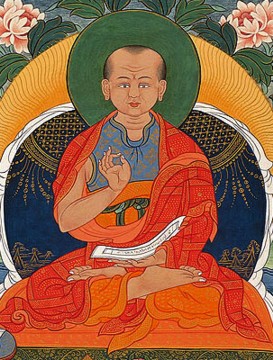|
|

楼主 |
发表于 2012-4-13 06:57
|
显示全部楼层
附件04.
Geshe Langri Tangpa  Geshe Langri Tangpa Geshe Langri Tangpa
Geshe Langri Tangpa (Tib. དགེ་བཤེས་གླང་རི་ཐང་པ་, Wyl. dge bshes glang ri thang pa) (1054-1123 ), aka. Langthangpa Dorje Senge (གླང་ཐང་པ་རྡོ་རྗེ་སེངྒེ་glang thang pa rdo rje seng+ge) — a famous Kadampa master and disciple of Potowa Rinchen Sal, who is best known for composing the Eight Verses of Training the Mind.
Kyabjé Trulshik Rinpoche says:
Among the Kadampa masters, there was one called Geshe Langri Thangpa, who was an incredible teacher and a really great master. He is said to have set the standard for meditation on the defects of samsara. In fact, he was even known as ‘Langthangpa Gloomy Face,’ because he never ever smiled. Except, that is, on one occasion when a mouse tried to move a piece of turquoise on his mandala plate. The mouse was trying desperately to push the turquoise but could not manage, so he called over another mouse to come and help him and together they tried to move it. That made Langri Thangpa smile, it is said, but apart from that, he had a permanently gloomy expression, and so people used to call him “gloomy face.” Once, it is said, his attendant told him how people were calling him “gloomy face” because he never smiled, and he replied, “When I think about all the endless suffering in the different realms of samsara, how could I ever possibly smile?” |
|